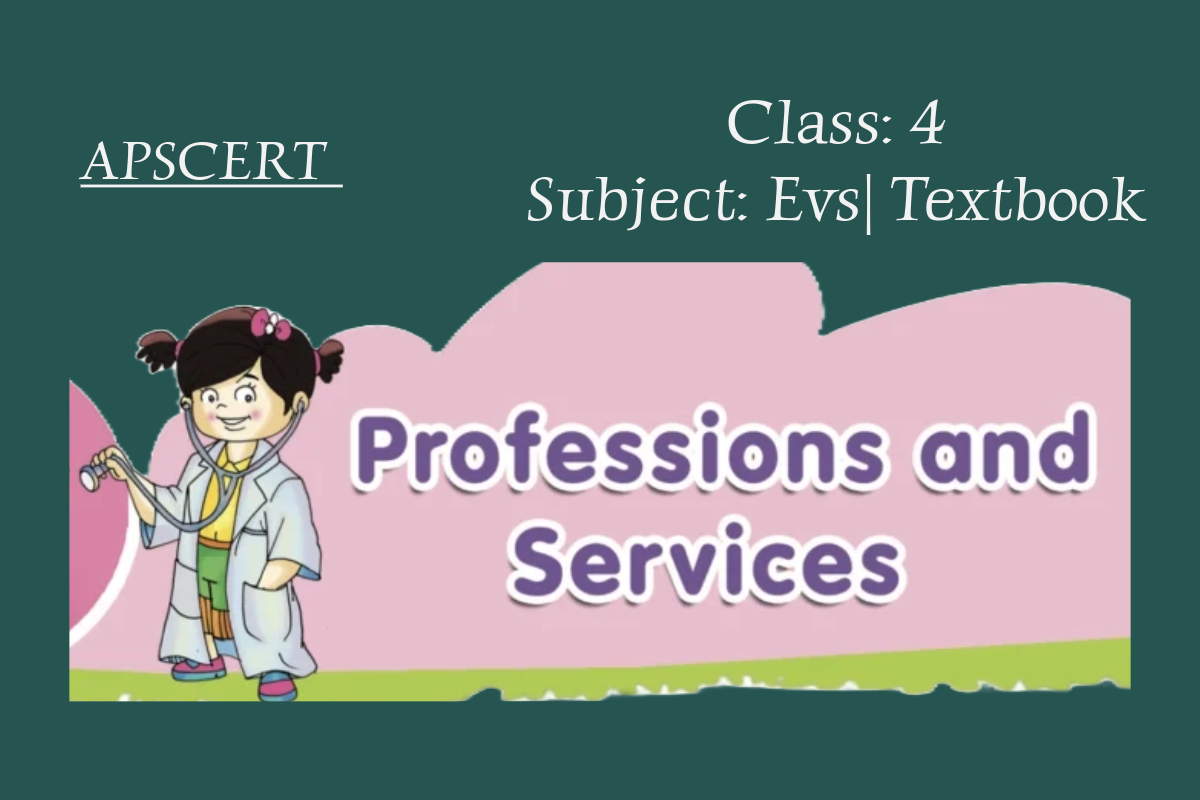Your cart is currently empty!
Chapter: 7 | professions and service | Class 4 | Evs | Textbook

APSCERT | ANDHRA PRADESH
Here are the answers to the “Improve your Learning” section from the lesson “Chapter: 7 | Professions and service | Class 4 | Evs | Textbook”.
I. Conceptual Understanding.
1. Name any three professions by which people help us in our daily life.
Three professions by which people help us in our daily life are:
- Doctor – Helps us by treating illnesses and maintaining our health.
- Teacher – Educates and guides students in learning.
- Farmer – Grows crops and provides us with food.
2. Which professions support a farmer in farming?
Professions that support a farmer in farming include:
- Agricultural Officer – Provides seeds, tools, and guidance on modern farming techniques.
- Bank Manager – Offers loans at low interest rates to help farmers with financial support.
- Electrical Engineer – Ensures power supply needed for operating pumps, machinery, and other equipment on the farm.
3. Write how a plumber helps you.
A plumber helps by installing and repairing water systems, such as pipes, taps, and drainage systems in homes and buildings. They ensure that we have access to clean water and that wastewater is properly managed, which is essential for hygiene and daily activities like cooking, cleaning, and bathing.
II. Questioning and Hypothesis.
4. What questions would you like to ask a grocer in your village about his/her profession?
Here are some questions I would ask a grocer in my village about their profession:
- Where do you get the fruits and vegetables you sell?
- How do you decide the prices for different items?
- What challenges do you face in your work?
- How do you make sure that the items you sell are fresh?
- What are the most popular items that people buy from your store?
III. Experiments and Field Observations.
5. Visit a cobbler in your village. Observe how he repairs the shoes.
I visited the cobbler in my village and watched how he repairs shoes. First, he looks at the broken shoe to see what needs fixing. Then, he uses glue to stick any parts that have come loose. If the sole is damaged, he carefully removes it and puts on a new one with glue and nails. He also uses a needle and strong thread to stitch any torn parts. Finally, he polishes the shoes to make them look new again. It was interesting to see how he works with his tools and makes old shoes useful again!
IV. Information Skills and Projects.
6. Collect pictures of tools used by different professionals from newspapers and prepare a scrap book.
To complete this activity, collect pictures of tools used by various professionals. Look in newspapers, magazines, or even online (with the help of an adult) to find pictures. Here are some ideas:
- Doctor’s Tools – Stethoscope, thermometer, and blood pressure monitor.
- Tailor’s Tools – Scissors, measuring tape, and sewing machine.
- Farmer’s Tools – Plough, shovel, and tractor.
- Mason’s Tools – Hammer, trowel, and bricks.
- Carpenter’s Tools – Saw, hammer, and chisel.
Cut out the pictures and stick them in a scrapbook. Label each picture with the name of the tool and the profession that uses it. This scrapbook will help you learn about different professions and their tools!
V. Drawing and Model making.
7. Draw and colour the picture of a sickle or any tool in your workbook.

VI. Appreciation.
8. How would you appreciate the services of a scavenger in your village?
I would appreciate the services of a scavenger in my village by saying thank you for the hard work they do every day to keep our surroundings clean. They collect garbage and keep the streets and public places tidy, which helps prevent the spread of diseases. I would also show respect by greeting them kindly, helping spread awareness about their important work, and encouraging others to keep the area clean so their job becomes easier. Their work is valuable, and we should respect and thank them for keeping our village safe and healthy.
9. Look at the pictures and write how you feel about them.

Looking at these pictures, I feel happy and appreciative. They show a farmer taking care of his buffalo by cleaning, feeding, and milking it. It shows the hard work and care involved in looking after animals that help us in our daily lives. The farmer looks gentle and kind to the buffalo, and the bond between them is heartwarming. This reminds me how important animals are in farming and how farmers work hard to provide us with milk and other resources. It also shows that taking good care of animals is essential and that we should respect both farmers and their animals.

Leave a Reply
You must be logged in to post a comment.